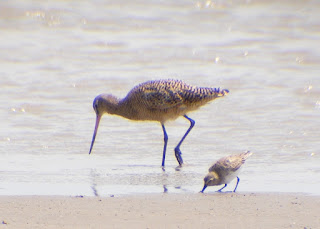However, one digiscoper I know has managed to figure out how to digiscope the small birds as well as big. He gets some amazing results too.
Here's the link to his website:
http://birddigiscoping.com/
Some of you may recognize the url. The website belongs to Mike McDowell. He lives in Madison WI, about an hour's drive from me. He's a great birder and a superb digiscoper.
For the average digiscoper, a setup like mine works very well. Especially if you just want a few decent pictures. There are problems with it though.
For example, at medium to long distances, light distortion becomes a problem.
Here's an example of light distortion at a medium distance:

Note the bluish coloring outlining the birds. The only way to get rid of that is to go to a better quality scope.
Digiscoping works only at low zoom levels. Here's an example of light loss at a higher zoom level. I took this picture at Horicon Marsh yesterday. I zoomed my scope to about 30X and then zoomed my camera to 10X:
The birds are IDable but the picture is not really good quality at all.
Here's an example of even lower light. I took this picture right around Sunset at the County C & V ponds in Dane County:
So long distances aren't good and low light is worse.
Here's an example of a picture taken at medium brightness (AKA partly cloudy, overcast, but the middle of the day), but the bird is much closer than the last one. Range was less than 30yds:

There's a little more clearity. I didn't get the focus I wanted because the bird was moving but it turned out ok.

There's a little more clearity. I didn't get the focus I wanted because the bird was moving but it turned out ok.
Here's a Swamp Sparrow at about the same light level but slightly farther away:
The best time for digiscoping is when the birds sit still and are close and it's a clear, sunny day.
On the above picture, the sun was almost behind the bird so the light wasn't absolutely perfect.
Here's one where you just have to wait for the right time to take the picture:

The light reflecting off the water screwed this one up a little. It still came out pretty decent though:

The light reflecting off the water screwed this one up a little. It still came out pretty decent though:
This bird was a little less than 30 feet away in bright sunlight. Note the clarity of the picture despite the fact that the wind was blowing at a steady 30Mph that day:


Here's an example of a Prothonotary Warbler that I took at Boyscout Woods in High Island TX on a slightly cloudy day with all kinds of shadows around from the trees:

Now, the comparison. For this Louisiana Waterthrush, I used the same camera on the same settings, in the same light at the same place. The only difference was the scope I used.
For this picture, I borrowed a Swarovski 80HD:
You can see the difference. Now imagine that I had also used a really good quality camera.....
In the end, if you want really good pictures. It's going to cost you money. The Swaro 80HD runs at around $2000.... minus a good camera. Add the camera and you're talking around $2500-$2800
A Canon 40D + a 100-400mm lens runs in around $3000.
For me, the camera setup is more economical. Plus, it's faster and more agile.







1 comment:
Great information! I never realized how much goes into digiscoping. I hardly every digiscope, but now I understand why some of my pictures come out the way they do!
Your pictures are great. I especially like the last one.
Happy birding (and digiscoping!)
Andrea
Post a Comment